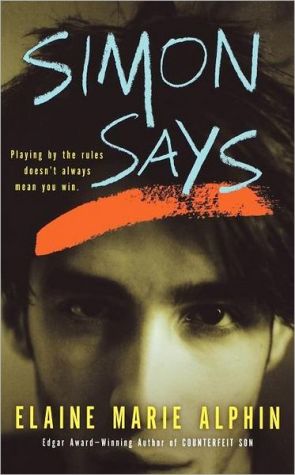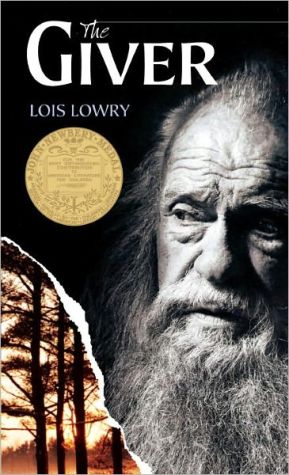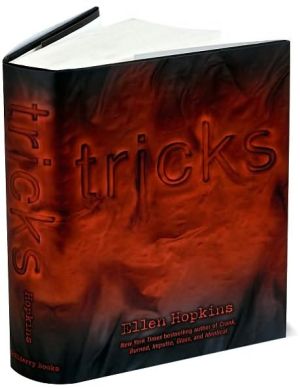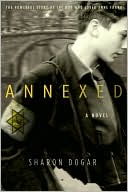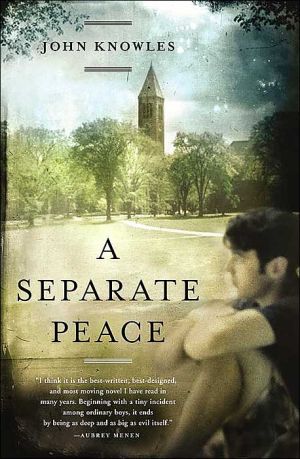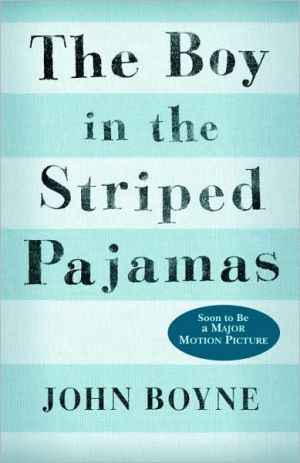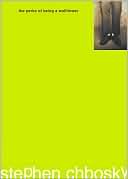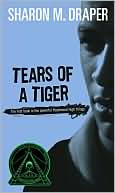Simon Says
Aspiring young artist, Charles Weston has enrolled in a private arts high school soley to meet the "famous" Graeme Brandt, a student whose recently published novel touched a chord deep within Charles.\ But Graeme is not at all what Charles expected, and soon the two teen prodigies are drawn into a clash of wills that threatens to destroy them both.\ \ \ An alienated, aspiring young painter who attends high school at a boarding school for the arts discovers that being...
Search in google:
Charles Weston, an aspiring young artist attending a private arts high school, discovers that being true to one's self means opening the door to both pain and pleasure.Publishers WeeklyHigh school junior Charles Weston, whose paintings convey "truth" so powerfully that all who see them promptly fear and/or dislike him, has just arrived at Whitman, a boarding school for artists. The school's amenities notwithstanding, Charles has enrolled simply in order to meet Graeme Brandt, a senior, and author of a YA novel that Charles finds brilliant in its send-up of people's shallowness ("Life is just one big game of Simon Says.... Nobody even wants to admit they're playing"). Charles, who now refuses to let others see his paintings, is hoping that Graeme can show him "how to get beyond the game... show me how to keep from locking myself away inside a studio forever." While the boys connect immediately, Charles realizes that Graeme is also "playing," just like Graeme's protagonist ("He knew what Simon wanted before Simon even said anything"). When Charles pushes Graeme to find his true self ("You're nothing but a lifeless mirror that reflects everyone's expectations!"), Graeme commits suicide and camouflages it as a heart attack, leaving a note explaining his actions to Charles. Alphin (Counterfeit Son) adds texture by inserting Graeme's journals between Charles's narration, and she brings unusual candor to her portrayal of gay characters. But while the author taps into adolescent visions of the artist's life and the difficulties of being an individual, her constant reiteration of these themes grows tiresome. Metaphors run a little thick, and the quagmires seemed overcooked. Ages 14-up. (May) Copyright 2002 Cahners Business Information.
The mirror acts like a frame. But I would never paint on a shiny, reflective surface like that. Canvas draws the paint into it, draws the eye into it, draws the mind into its world. Mirrored glass shows too much, and too little. I came here to get away from games played with mirrors.\ I always knew there had to be someone else who saw the games for what they were, someone else who hated them as much as I do. That's why I came to Whitman High School for the Arts-to meet this person. Only now I'm not so sure. Why should he care about meeting me?\ "Well, Charles, are you coming or not?" Adrian demands. His voice fills our dorm room, easy and amused, blue-green tones flecked with golden highlights. "This was your idea, remember."\ I remember. In the mirror I see sweaty fingers wiping themselves on a T-shirt as if they were paint-smeared, then fumbling to smooth the stretched-out cotton. Above the fingers I see frowning eyes that might be mistaken for angry instead of nervous.\ "Having second thoughts?" asks Adrian.\ I grab a rust-colored flannel shirt and shrug into it, letting it hang open over the T-shirt. Glancing in the mirror one last time, I meet my new roommate's hazel eyes. Sleek in black jeans and an open-necked gray shirt, a plaid so fine it looks like graph paper, Adrian smiles at me, an ironic smile that masks a brain like a shrink's. No one's been so on-target reading my mind since my mother when I was a little kid, and I don't like it.\ He cocks his head and raises one eyebrow suggestively over long lashes. If I were to sketch Adrian, I think I'd show him charming his prey. He'd have them trapped, spellbound: a siren wooing Odysseus. It's been two days since I met him, and I already know he can charm anyone, girl or guy. Turns out the guys are the only ones he's interested in.\ I can't believe he's my roommate-you'd think they'd put something like that on the dorm questionnaire. I'm not sure how I feel about it, actually. I know how I should feel, but I don't. What does that say about me? Maybe...just that I don't care. I didn't come here to meet Adrian. He doesn't matter-he's only a stranger in the other half of the room. He pretends he's interested, but he doesn't know me, for all that shrink's brain of his. He sees only what the school calls me: artist; the way it calls him composer. He's already heard that no one knows what I paint. He probably thinks I'm either the next thing to hit the Museum of Modern Art or the next overrated boy wonder to hit the trash can. But what would he think if he saw my work? Maybe he'd shut off those signals, at least.\ "So let's go," I tell him, sliding my sketch pad into a small backpack and slinging it over my shoulder. I keep my voice light, like I don't care one way or the other about the evening. He doesn't look like he buys it, though. If he's a composer, he probably has a fine-tuned ear. Well, he can hear what he likes. It doesn't make any difference to me.\ We walk through the muggy Houston evening, hearing the screech of shadowy birds clustered in the trees above. I breathe through my mouth to avoid the pungent reek of their droppings. A migratory stop- What does that say about Whitman, as a cowbird dumping ground? We keep our pace steady and stay silent, not wanting to alarm the birds.\ I could have gone to this meeting alone. But Orientation Week parties are set up by department. I went to the one for visual arts last night and saw hardly any new students from other subject areas. Adrian's music bash is tomorrow. Neither of us has an excuse for crashing the writers' party tonight. No one was checking lists last night, but I thought I'd stand out less if there were two of us from different departments. Maybe they wouldn't realize it was just me who wanted in.\ Clear of the birds, Adrian leans his head back so the warm breeze ruffles his longish russet hair, this come-take-me look on his face. I glance away. Then he whistles Borodin.\ I hear the lyric in my head-"Take my hand, I'm a stranger in paradise"-and have to grin. This place is paradise, for all of us. No more high school math and science nerds, no more worries about SATs, no more jocks, no more gangs, no more parents hanging over us, thinking they know better because they've already grown up. We have to take some regular classes, sure, but it's clear they take a backseat to our real work. Studios, practice halls, performance auditoriums-they take up more campus space than classrooms. If there's a place I might actually fit in, it could be Whitman.\ Adrian glances at me and breaks off his whistling to grin back, and for a moment it's like having a friend. Then I look away.\ The student center swims hazily into focus through the twilight, and I wipe my forehead, wishing I hadn't pulled on the flannel shirt.\ "One word of advice, dear," Adrian murmurs. "Never let them see you sweat."\ "Then I'll have to either get out of Houston or start lugging around my own air conditioner," I retort, though it's not just the outdoor temperature that's making me sweat.\ Adrian wrinkles his nose. "Now that would surely make you sweat."\ Now we're past the cobblestone front walk and at the massive bronze doors bordered with reliefs of the muses. Corny, but also neat to see the arts taken seriously, like coming home-or more, almost like belonging. That would have been reason enough to come to Whitman, even without wanting to meet him. Or maybe they're not such different reasons.\ Adrian pulls the door open grandly, and bows me into the air-conditioned front hallway reeking of lemon-scented polish. Sometimes I think he should be in the theater department. Maybe we both should. As I walk past, Adrian declaims, "Show time!" and I wince inside. How can he read me so well?\ In the jumble of bodies in the main room, I can already spot the new kids-too keyed up, wary, wanting to make the right impression but not yet sure whom to impress. No-that's how they felt last night, at the visual arts get-together. And that's how they'll feel tomorrow at Adrian's music party. But tonight everyone knows whom they want to impress: Graeme Brandt.\ Copyright © 2002 by Elaine Marie Alphin\ All rights reserved. No part of this publication may be reproduced or transmitted in any form or by any means, electronic or mechanical,\ including photocopy, recording, or any information storage and retrieval system, without permission in writing from the publisher.\ Requests for permission to make copies of any part of the work should be mailed to the following address: Permissions Department,\ Harcourt, Inc., 6277 Sea Harbor Drive, Orlando, Florida 32887-6777.\ www.HarcourtBooks.com
\ Publishers WeeklyHigh school junior Charles Weston, whose paintings convey "truth" so powerfully that all who see them promptly fear and/or dislike him, has just arrived at Whitman, a boarding school for artists. The school's amenities notwithstanding, Charles has enrolled simply in order to meet Graeme Brandt, a senior, and author of a YA novel that Charles finds brilliant in its send-up of people's shallowness ("Life is just one big game of Simon Says.... Nobody even wants to admit they're playing"). Charles, who now refuses to let others see his paintings, is hoping that Graeme can show him "how to get beyond the game... show me how to keep from locking myself away inside a studio forever." While the boys connect immediately, Charles realizes that Graeme is also "playing," just like Graeme's protagonist ("He knew what Simon wanted before Simon even said anything"). When Charles pushes Graeme to find his true self ("You're nothing but a lifeless mirror that reflects everyone's expectations!"), Graeme commits suicide and camouflages it as a heart attack, leaving a note explaining his actions to Charles. Alphin (Counterfeit Son) adds texture by inserting Graeme's journals between Charles's narration, and she brings unusual candor to her portrayal of gay characters. But while the author taps into adolescent visions of the artist's life and the difficulties of being an individual, her constant reiteration of these themes grows tiresome. Metaphors run a little thick, and the quagmires seemed overcooked. Ages 14-up. (May) Copyright 2002 Cahners Business Information.\ \ \ \ \ From The CriticsFor sixteen-year-old Charles Weston, life feels like a game of Simon Says, with parents, teachers, and peers imposing their expectations on him. Determined to figure out how to be true to himself and to his art, Charles enters a boarding school for gifted artists. A painful history of rejection leads him to close himself off from everyone, hiding the powerful truth about life in his painting. Captivated by the profundity of a fellow student's novel, Charles befriends the author. However, Charles discovers that the one he thought could show him how to escape the expectation game is really the best player of all. Capturing the inner reality of the artist, Simon Says wrestles with intense themes of identity, homosexuality, and suicide. High school students will find Charles' journey to self-expression thought provoking as he learns to connect with others, and to remain true to himself, regardless of others' expectations. 2002, Harcourt, 258 pp., \ — Sarah Gartland\ \ \ KLIATTThis unusual and compelling novel takes readers inside Whitman High School for the Arts, where students argue about things like whether or not Ravel based his quartet on Debussy's work. Alphin takes readers into the psyches of students whose friendships are founded upon their passion for artistic expression. Against the wishes of his practical parents, Charles Weston has come to Whitman not to pursue his art studies but to meet Graeme Brandt, the young author of a novel called The Eye of the Storm. Because his novel mocks the great game of life, Simon Says, its author must know the secret of how to avoid reflecting back to others only the person they want to see. Unexpected help comes in the form of Adrian, a gay musician/composer, and Rachel, to whom Charles represents both a kindred spirit and also one of her most challenging puzzles to solve. If, in the final pages, the author expends unnecessary energy to drive home her point, she gets everything else just right. Do we choose who we are or are we born that way? These and other questions raised in the novel provide plenty of scope for discussion. KLIATT Codes: S—Recommended for senior high school students. 2002, Harcourt, 258p., Ages 15 to 18. \ —Jessica Swaim\ \ \ \ \ School Library JournalGr 8 Up-In this psychological novel, Charles enters a boarding school for the arts hoping to find a place where he can stay true to his nonconformist nature. Absorbed with painting in a vivid and distorted way, he wants to make friends with people who like him for himself and teachers who will accept his work. As in the children's game Simon Says, he finds himself mirroring others rather than pleasing himself. Charles knows that Graeme, a student writer whom he idolizes, shares a search for identity. Excerpts from Graeme's journal appear at intervals, revealing a parallel childhood. Elements of a homosexual crush draw the two together but the path to self-realization has a tragic end when Graeme commits suicide. As in many YA novels, the adults here are peripheral and antagonistic, providing a perfect setting for self-perceived isolation. Charles's musical roommate, Adrian, and the editor of the student journal, Rachel, are well-developed supporting characters who, as grounded individuals, become the ones who ultimately help the protagonist feel a sense of belonging. Plot development is emotional rather than eventful, and some of the details surrounding Graeme's death are not plausible. It defies logic that, in a small boarding school, Charles would learn about the teen's "fatal heart attack" from the newspaper. Still, adolescents will relate to the disconnected characters who feel painfully alone and will be encouraged by the acceptance of their uniqueness.-Vicki Reutter, Cazenovia High School, NY Copyright 2002 Cahners Business Information.\ \ \ \ \ Kirkus ReviewsThis overly long novel explores large issues about Art and Truth, but fails to create compelling characters or plot that will keep readers engaged. While Alphin's highly readable Counterfeit Son (2000) crackled with suspense, this one sets the reader up for disappointment from the beginning. The first page describes the grave of a dead student, visited by his murderer. But there is no murder, only a suicide for which one character feels guilty. Telling rather than showing, narrator Charles explains why he transferred to an arts school as a junior. He presents himself in long, repetitive monologues as an arrogant, anguished painter, unappreciated by his parents and boorish teachers, ostracized by jealous classmates since preschool. His bleakly truthful paintings, executed without training, make everyone so uncomfortable that they reject him. Now he won't let anyone see his paintings for fear of further rejection, conveniently overlooking the fact that he won a scholarship based on his art. At the boarding school, he forms a tentative friendship, heightened by sexual tension, with Graeme, a senior famous for having a novel published as a sophomore. Charles hopes Graeme can tell him how to survive without conforming to others' expectations, but Graeme's occasional journal entries reveal how few answers he has. While Charles's self-righteous, self-absorbed character is plausible, his voice quickly becomes tedious. Some teenage artists may see themselves here, but most readers will tire of Charles long before his final epiphany about life and art. (Fiction. YA)\ \
